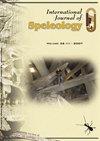洞穴入口位置的预测建模:地表和地下形态之间的关系
IF 1.3
4区 地球科学
Q3 GEOSCIENCES, MULTIDISCIPLINARY
引用次数: 0
摘要
洞穴入口直接连接岩溶景观的地表和地下地貌。了解这些特征的空间分布可以帮助识别景观上对岩溶地下水系统流动至关重要的区域。沉孔和泉水分别是地下水系统流入和流出的主要位置,但并非所有沉孔和泉都平等地连接到主管道系统。预测高连通性景观带的位置是一项挑战,因为洞穴入口很难检测到,而且记录不完整。野生动物研究也有类似的问题,即在信息不完整和仅存在数据的情况下,了解特定物种可能存在于景观中的复杂性。物种分布模型可以解决其中一些问题,从而准确预测整个景观中的物种或事件发生。在这里,我们应用一个物种分布模型MaxEnt来预测肯塔基州三个地貌区的洞穴入口位置。我们利用肯塔基州地质调查数据库中的洞穴位置和景观预测变量建立了模型,包括与天坑的距离、与泉水的距离、距断层的距离、海拔、岩性、坡度和方位。所有三个区域模型都能很好地预测洞穴位置,预测洞穴入口位置的最重要变量在模型之间是一致的。在所有三个模型中,天坑和泉水对洞穴入口的可能性影响最大。物种分布建模技术的这种独特用途表明,它们是理解其他景观特征空间模式的潜在有价值的工具,这些景观特征要么是短暂的,要么难以使用标准技术识别。本文章由计算机程序翻译,如有差异,请以英文原文为准。
Predictive modeling of cave entrance locations: relationships between surface and subsurface morphology
Cave entrances directly connect the surface and subsurface geomorphology in karst landscapes. Understanding the spatial distribution of these features can help identify areas on the landscape that are critical to flow in the karst groundwater system. Sinkholes and springs are major locations of inflow and outflow from the groundwater system, respectively, however not all sinkholes and springs are equally connected to the main conduit system. Predicting where on the landscape zones of high connectivity exist is a challenge because cave entrances are difficult to detect and imperfectly documented. Wildlife research has a similar issue of understanding the complexities of where a given species is likely to exist on a landscape given incomplete information and presence-only data. Species distribution models can address some of these issues to create accurate predictions of species or event occurrence across the landscape. Here we apply a species distribution model, MaxEnt, to predict cave entrance locations in three geomorphic regions of Kentucky. We built the models with cave locations from the Kentucky Speleological Survey database and landscape predictor variables, including distance from sinkholes, distance from springs, distance from faults, elevation, lithology, slope, and aspect. All three regional models predict cave locations well with the most important variables for predicting cave entrance locations consistent between models. Throughout all three models, sinkholes and springs had the largest influence on the likelihood of cave entrance presence. This unique use of species distribution modeling techniques shows that they are potentially valuable tools to understand spatial patterns of other landscape features that are either ephemeral or difficult to identify using standard techniques.
求助全文
通过发布文献求助,成功后即可免费获取论文全文。
去求助
来源期刊

International Journal of Speleology
地学-地球科学综合
CiteScore
3.10
自引率
23.10%
发文量
12
审稿时长
>12 weeks
期刊介绍:
The International Journal of Speleology has the aim to get cave and karst science known to an increasing number of scientists and scholars. The journal therefore offers the opportunity to all scientists working in and on karst to publish their original research articles or their review papers in an open access, high quality peer reviewed scientific journal at no cost. The journal offers the authors online first, open access, a free PDF of their article, and a wide range of abstracting and indexing services.
 求助内容:
求助内容: 应助结果提醒方式:
应助结果提醒方式:


